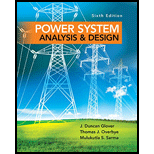
Concept explainers
Consider a single-phase load with an applied voltage
Trending nowThis is a popular solution!

Chapter 2 Solutions
Power System Analysis and Design (MindTap Course List)
- A 50 Hz, 250 V single phase power line has the following loads placed across it in parallel; 4 kW ata pf of 0. 8 lagging; 6 kVA at a pf of 0.6 lagging; 5 kVA which includes 1.2 kVAR leading. Determinethe overall pf of the system and the capacitance of the capacitor which, if connected across themains restore the power factor to unity.arrow_forwardA three-phase system includes a 346.4 V line-to-line supplying a three-phase motor rated 15KVA 0.8pf lag plus additional balanced constant impedance loads. The single-phase representation of the system is shown below. Assume that sources and loads are Y-connected. 1. What is the RMS value of the line current, I in A? 2. If this set of loads will be supplied through a service transformer. What should the minimum size of the transformer in kVA? 3. What should be the size of three-phase capacitor(that will be added to the load mix) to improve power factor to almost 0.95 lag?arrow_forwardThe impedance of an electrical circuit is (30 − j50) ohms. Determine (a) the resistance, (b) the capacitance, (c) the modulus of the impedance, and (d) the current flowing and its phase angle, when the circuit is connected to a 240V, 50 Hz supply.arrow_forward
- A 3-phase, 50-Hz overhead transmission line 100 km long has the following constants : Resistance/km/phase = 0.1 Ω Inductive reactance/km/phase = 0·2 Ω Capacitive susceptance/km/phase = 0·04 × 10− 4 siemens Determine sending end voltage when supplying a balanced load of 10,000 kW at 66 kV, p.f. 0·8 lagging. Use nominal T method . Select one: a. 330 kV b. 52 kV c. None of the above d. 69.5 kVarrow_forwardIn Industry, three Inductive loads, each of resistance R = 30 ohms and inductance L = 0.12 H are connected in Delta to a 430 V, F = 50 Hz, 3 phase supply. Find the following below: Phase Impedance, Zp = Phase Voltage, Vp = Phase current, Ip = Line current, IL= The Total Power Consumed, P =arrow_forwardIn Industry, three Inductive loads each of resistance = 32 ohms and inductance L = 0.16 H are connected in Delta to a 400 V, F = 50 Hz, 3 phase supply. Find the following below: Phase Impedance, Zp = Phase Voltage, Vp = Phase current, Ip = Line current, I= The Total Power Consumed, p =arrow_forward
- please solve this question with complete solution : A 50 Hz, 250 V single phase power line has the following loads placed across it in parallel; 4 kW ata pf of 0. 8 lagging; 6 kVA at a pf of 0.6 lagging; 5 kVA which includes 1.2 kVAR leading. Determinethe overall pf of the system and the capacitance of the capacitor which, if connected across themains restore the power factor to unity.arrow_forwardA 3-phase, 50-Hz overhead transmission line 100 km long has the following constants : Resistance/km/phase = 0.1 Q Inductive reactance/km/phase = 0-2 N Capacitive susceptance/km/phase = 0-04 × 10- 4 siemenS Determine sending end voltage when supplying a balanced load 10,000 kW at 66 kV, p.f. 0-8 lagging. Use nominal T method . Select one: a. 330 kV b. None of the above c. 52 kV d. 69.5 kVarrow_forwardAn alternating single-phase circuit describes the instantaneous values of the applied voltage and the corresponding current as: v = 360 sin (201,69 t + π/6) and i = 36 sin (201,69 t - π/9) Calculate: the frequency (1) the phase angle, in degrees, (1) the power factor of the circuit (1) the value of the voltage and current 10 ms after zero, (2) the impedance, resistance and reactance of the circuit, (3) the r.m.s.-values of the voltage and current, (2) the true-, apparent- and reactive power in the circuit (3) The time taken to reach -190 V for the second time. (3) Sketch the phasor diagram of this circuit (2)arrow_forward
- Please solve A line with impedance of 1 +j 0.32 Q is used to deliver power to a load. The load is inductive and the load voltage is 220 0° Vrms at 50Hz. If the load operates at 40 kw with a power factor of 0.75 lagging, determine the complex power in both the load and the line current. 9.2) draw the phasor diagram for the circuit, 9.3) calculate the power savings if power factor is changed to .95.arrow_forwardAn industrial plant is supplied from 400V 50Hz power system. The plant consists of (i) 2x50kW pure resistive heating furnace(ii) 5x25kW induction motor having a lagging power factor of 0.85(iii) A compressor unit drawing 80kW active power and 60kVAr inductive reactive power. Calculate per phase capacitance of delta (∆) connected reactive power compensation system to set the power factor of the industrial power plant to 0.98 leading.arrow_forward6.8. A three phase, 50 Hz, 100 km transmission line has resistance 0.1 ohms/km, inductance 111.7 mH/km and capacitance 0.9954 x 10- uF/ph per km. The line is delivering 20 MW at a 0.8 power factor lagging and 66 kV to a balanced load. Determine the efficiency and regulation. Use nominal it method. Ans. n= 93.5%, VR = 17.47%arrow_forward
 Introductory Circuit Analysis (13th Edition)Electrical EngineeringISBN:9780133923605Author:Robert L. BoylestadPublisher:PEARSON
Introductory Circuit Analysis (13th Edition)Electrical EngineeringISBN:9780133923605Author:Robert L. BoylestadPublisher:PEARSON Delmar's Standard Textbook Of ElectricityElectrical EngineeringISBN:9781337900348Author:Stephen L. HermanPublisher:Cengage Learning
Delmar's Standard Textbook Of ElectricityElectrical EngineeringISBN:9781337900348Author:Stephen L. HermanPublisher:Cengage Learning Programmable Logic ControllersElectrical EngineeringISBN:9780073373843Author:Frank D. PetruzellaPublisher:McGraw-Hill Education
Programmable Logic ControllersElectrical EngineeringISBN:9780073373843Author:Frank D. PetruzellaPublisher:McGraw-Hill Education Fundamentals of Electric CircuitsElectrical EngineeringISBN:9780078028229Author:Charles K Alexander, Matthew SadikuPublisher:McGraw-Hill Education
Fundamentals of Electric CircuitsElectrical EngineeringISBN:9780078028229Author:Charles K Alexander, Matthew SadikuPublisher:McGraw-Hill Education Electric Circuits. (11th Edition)Electrical EngineeringISBN:9780134746968Author:James W. Nilsson, Susan RiedelPublisher:PEARSON
Electric Circuits. (11th Edition)Electrical EngineeringISBN:9780134746968Author:James W. Nilsson, Susan RiedelPublisher:PEARSON Engineering ElectromagneticsElectrical EngineeringISBN:9780078028151Author:Hayt, William H. (william Hart), Jr, BUCK, John A.Publisher:Mcgraw-hill Education,
Engineering ElectromagneticsElectrical EngineeringISBN:9780078028151Author:Hayt, William H. (william Hart), Jr, BUCK, John A.Publisher:Mcgraw-hill Education,





